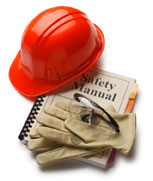By Chuck Dingman, CIH, CSP Industrial Hygiene Services Manager, Total Safety
 So your manager has instructed you to develop a new Industrial Hygiene Program or correct deficiencies in the current program for your organization. Just what does that mean, and where do you begin?
So your manager has instructed you to develop a new Industrial Hygiene Program or correct deficiencies in the current program for your organization. Just what does that mean, and where do you begin?
Simply stated, the field of industrial hygiene encompasses agents and conditions that can impact employee health and well-being in the work environment. The list of potential factors or stressors that can impact health and well-being include exposure to chemicals, high noise levels, ionizing and non-ionizing radiation, biological organisms, temperature extremes and ergonomic hazards. All these hazards must be assessed and controls implemented where unacceptable exposure conditions exist. Potential controls include hearing conservation, respiratory protection, radiation safety, heat stress, medical surveillance programs, and work practice and engineering controls. These programs and controls must be managed effectively to protect employee health and well-being. But which programs and controls do you really need?
The Workplace Exposure Assessment Process
There are two options available to you for identifying needed programs and controls. The first is to spend your time, money and effort putting out fires, i.e. reacting to workplace complaints, concerns and demands. The other option is to conduct a comprehensive, systematic assessment of needs and implement a proactive program to address and manage those needs. In either case, the assignment can be daunting, but can be made manageable with the right approach. The Workplace Exposure Assessment (WEA) process provides one such approach.
Traditionally, the WEA process was developed to evaluate potential chemical exposures. With modifications, the same WEA process can, however, be applied to evaluate nearly all potential industrial hygiene health risks.
The process of performing a WEA involves a series of distinct steps. The first step in a chemical WEA is to identify job classifications with potential exposure to specific chemicals. Secondly, a list of tasks that involve potential exposure to those chemicals is made. Step three is to evaluate the toxicity of the chemicals using health codes developed for the Hazardous Materials Information System (HMIS), carcinogenicity ratings, and regulatory or recommended exposure limits.
Finally, a review is made of the respiratory exposure conditions based on the potential for the chemical to become airborne, ventilation or other control systems, and the frequency and duration to which workers may be exposed to the chemical. Workers in job classifications with similar exposure potential to specific chemicals are referred to as Similar or Homogenous Exposure Groups in the WEA process. Decision making logic within the WEA process is applied to produce a listing of SEGs prioritized from highest (A) to lowest (C) exposure potential. In the case of potential chemical exposures, industrial hygiene monitoring is performed initially for “A” priority SEGs and secondarily for “B” Priorities. “C” priorities are those determined through the WEA process to be in control.
Ultimately, the WEA process is used to drive the need for respiratory protection, hearing conservation, ventilation, medical surveillance, personal protective equipment, radiation protection or other industrial hygiene programs. Where programs are needed, a written program is developed that establishes procedurally the process by which the program will be implemented and managed. The end result of the process may be the determination that a program is not needed or can be eliminated. In this case, the organization has data and documentation justifying the lack of a particular program or termination of an ongoing program.
The WEA process does not guarantee success. Ultimate success will require ongoing management support and a focus on staying the course. In the real world, issues will arise that will require a shift in priorities from time to time. The goal is to ensure that these shifts are only temporary and that focus is returned to the systematic path you have charted once the issue is resolved.
For more infomation on how to develop an industrial hygiene program for your company, call us at 888.44.TOTAL.
Total Safety – The Best Minds in the Business!








